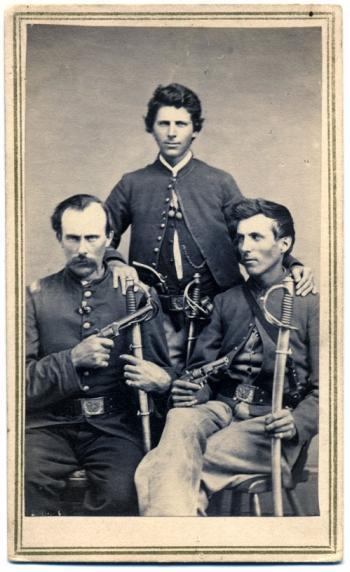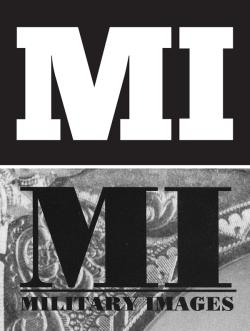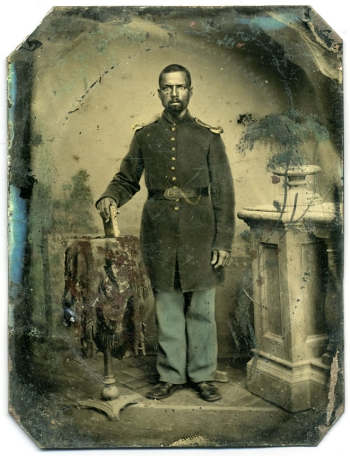Military Images Magazine

The Civil War Trust interviewed historian and author Ron Coddington, who recently became publisher and editor of Military Images magazine. Coddington explains the changes at the magazine and discusses the humanizing power of photography to tell the personal and military stories of the Civil War.
Civil War Trust: Which is the primary focus of Military Images magazine—photography, the Civil War or America’s military history?

Ron Coddington: MI’s primary focus is photography, especially military portrait photographs of American soldiers and sailors from the nineteenth and early twentieth centuries. Civil War images account for the vast majority of photographs you’ll find in the magazine—about 90 percent date from 1861-1865. The driving force of the magazine is its core group of contributors like David Wynn Vaughan, John Sickles and Mike McAfee—to name a few. These contributors are dedicated collectors of Civil War photography, many of whom I know through my own interest in Civil War photography (I started collecting when I was 14 years old). Our readership also has a keen interest in Civil War images. One of my first acts after taking the helm of MI was to survey the subscribers, something that had not been done in about 15 years. One of the survey questions asked if MI should expand into other periods in American history. A whopping 96.6% of those surveyed responded that the magazine should be left as it is.
How does the history of photography give us a better sense of America’s military history? What insight might these objects give us to understand the common soldier and make the Civil War relevant to people today?
RC: I vividly remember the impact that photographs of soldiers made on me in my first trip to the Gettysburg battlefield. Seeing soldiers’ stories and images on plaques and exhibits at the site solidified my belief that there is power and knowledge in looking into the eyes of these ordinary soldiers and learning about their extraordinary lives and military experiences.
Over time, I’ve come to understand and appreciate that these rare soldier portraits humanize the terrible conflict that raged on our soil during the four bloodiest and most violent years in our nation’s history. When I see these photos, which were personal, intimate objects shared with family, friends and comrades at a time of war, I am reminded of these soldiers’ courage, and my own responsibilities as an American and a world citizen.
It is only in the last few decades, beginning with the centennial of the war in the 1960s, that these old photographic portraits have begun to move from the realm of vernacular photography to become part of the nation’s visual record. Harry Roach, who founded MI in 1979, was in the forefront of those who realized the growing importance of these photographs.
You once wrote that “the history of the Civil War is the stories of its soldiers”— why is it important to know the histories of individual soldiers?

RC: This statement appears in the introduction of my second book, Faces of the Confederacy: An Album of Southern Soldiers and Their Stories. Believing, like British historian Thomas Carlyle, that “History is the essence of innumerable biographies,” I’ve come to understand that the personal experience of soldiers is an important part of our larger Civil War story.
I also believe that the images of those who served in the ranks, or as line officers and staff officers on the regimental level, are a vital part of our history. And thanks to the American technologists and entrepreneurs who democratized photography by making it more affordable to the masses, we have an amazing visual record of the Civil War soldier.
Military Images has long played a leading role in the identification and interpretation of these images. And with all this new material coming available, MI’s mission to educate and raise awareness is as important as ever.
How do you find information on an unidentified photograph?
RC: The first place I turn to is Military Images, and I’m not just saying this because I own the magazine! I’m a longtime subscriber, and know firsthand of the collective knowledge of the contributors and the readership. The best suggestion I can make is to submit your images along with what you know about the photograph. We’ll publish as many images as possible, and get the word out on social media. I’ve just revised the submission guidelines, working with our new copy editor, Jack Hurov. You can find more information here: www.militaryimagesmagazine.com/submissions
The MI logo was recently changed, reflecting a more modern look. What other efforts does a publication centered on old photographs make to maintain contemporary relevance?
RC: Design is one way to stay relevant and updating the logo was the first of several advances on the design front. The new logo font, Chunk Five, designed by Meredith Mandel for The League of Moveable Type, is bold and expansive, reminiscent of historic type, and one that displays well in print and online

The rest of the magazine is being redesigned from the ground up for the first time since 1979. It features a new grid that will support larger image display, and new headline and body type that will increase readability. Perhaps the biggest change readers will see is on the cover. It will be in full color for the first time in MI history. We’ll be able to reproduce color-tinted daguerreotypes, ambrotypes, tintypes, and cartes de visite in all their glory.
The organization of the magazine will not change. MI’s popular departments, including the Uniforms & History column, Stragglers, and The Last Shot, are all represented. Of course, readers will still find all the great feature articles and galleries for which MI is known. The columns, stories and galleries are really the key to staying relevant, because it is here that you’ll find never before published photographs and interpretation that only MI’s contributors can provide. The new design is intended to showcase their efforts.
How do MI’s Twitter, Flickr and Facebook accounts dovetail with the MI mission of showcasing and interpreting the visual record and stories of American soldiers?
RC: My very first move as publisher and editor was to establish Military Images on Twitter (@mil_images_mag), Flickr and Facebook because I believe social media is critical to success. MI has not participated in online communities up until now, and I think we have a real opportunity here to educate and raise awareness of historic images by adding the voice of our knowledgeable contributors and readers to amplify the conversation. I know also that MI can benefit from newly discovered images that surface from these sources. On Flickr, David C. Foster moderates Veterans of the American Civil War. There are also excellent images being posted on the Facebook group Civil War Faces.
I also want to expand our physical footprint, and so MI will have a presence at several collector shows in 2014. My wife, Anne, and I will be equipped with a portable scanner to make a high-resolution scans of images at the shows. We’ll makes the scans available to the owners, and seek permission to publish selected images in MI.
Does MI have any future plans for digitization or exhibition of these rare photographs?

RC: Archival preservation of this precious visual record is always in the front of my mind. I once calculated that there were 40 million photographs of Union soldiers taken during the Civil War. Even if only 10 percent survive, there are 4 million images out there today, spread out across the country in public and private institutions, and in the hands of families.
Archiving all of these rare images is a huge and long-term project. It will require a coalition of organizations to secure resources and mobilize an army of volunteers to locate, digitize, organize and make available historic photographs in a systematic way.
I encourage those with an interest in the preservation of these images to set a goal to preserve as many of these old photos as possible by the bicentennial of the Civil War. Although 50 years seems like a long time, it would require a sustained funding effort and a handoff to the next generation to complete the work. You can count Military Images in as a major player!
What role do you see MI playing in battlefield preservation?
RC: Military Images’ incredible resource of Civil War photographs should be a larger part of the Civil War story told on our battlefields. I encourage everyone involved with battle interpretation, like National Park Service personnel, to utilize MI as a source to add portrait photographs and soldier stories to their programs. While good work has been done on interpreting the larger military importance of battlefields through interpretive markers, I think battlefields can be improved by humanizing the war. The addition of faces and accounts of those who fought and died on those battlefields would add much to our appreciation and understanding of the Civil War.
I’m proud to be a regimental color bearer for the Trust myself and believe that the MI should contribute to the educational mission of the Civil War Trust. Part of the business plan for the magazine includes financial participation in support of CWT’s efforts.
Learn More: Military Images
Ron Coddington is a passionate collector of Civil War era photography, and a career journalist. He is a contributing author to the New York Times series Disunion, a columnist for the Civil War News, and the author of three books published by The Johns Hopkins University Press: Faces of the Civil War, Faces of the Confederacy, and African American Faces of the Civil War. His next volume in the series profiles sailors in the Union and Confederate navies. He became the fourth publisher and editor of Military Images magazine in August 2013.


